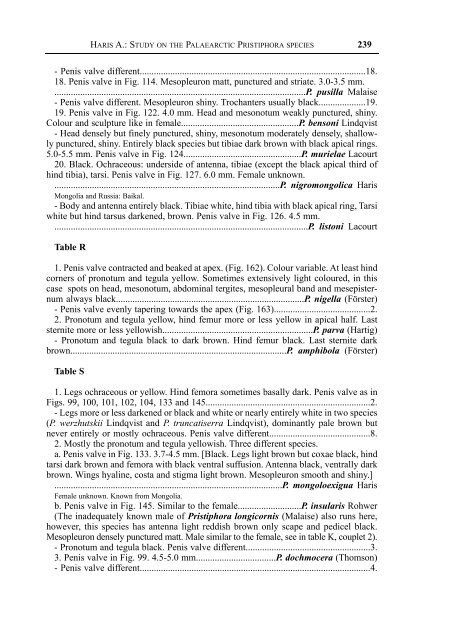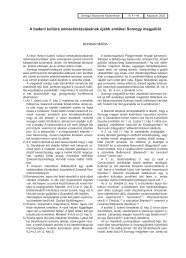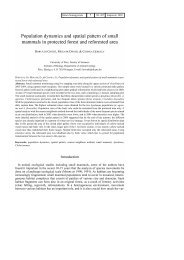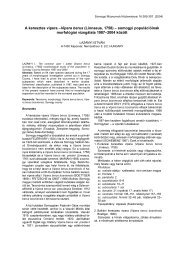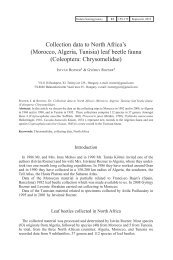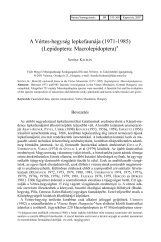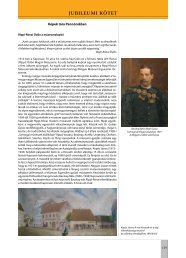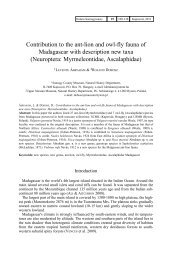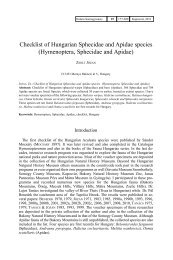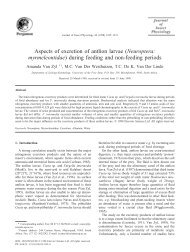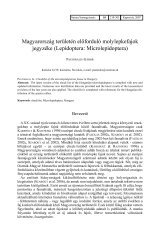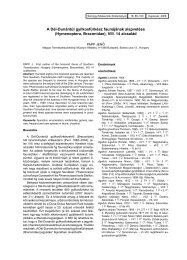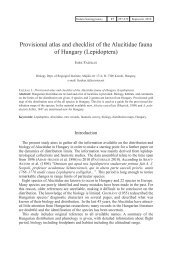Study on the Palaearctic Pristiphora species (Hymenoptera ...
Study on the Palaearctic Pristiphora species (Hymenoptera ...
Study on the Palaearctic Pristiphora species (Hymenoptera ...
Create successful ePaper yourself
Turn your PDF publications into a flip-book with our unique Google optimized e-Paper software.
HARIS A.: STUDY ON THE PALAEARCTIC PRISTIPHORA SPECIES<br />
239<br />
- Penis valve different................................................................................................18.<br />
18. Penis valve in Fig. 114. Mesopleur<strong>on</strong> matt, punctured and striate. 3.0-3.5 mm.<br />
...........................................................................................................P. pusilla Malaise<br />
- Penis valve different. Mesopleur<strong>on</strong> shiny. Trochanters usually black....................19.<br />
19. Penis valve in Fig. 122. 4.0 mm. Head and mes<strong>on</strong>otum weakly punctured, shiny.<br />
Colour and sculpture like in female..................................................P. bens<strong>on</strong>i Lindqvist<br />
- Head densely but finely punctured, shiny, mes<strong>on</strong>otum moderately densely, shallowly<br />
punctured, shiny. Entirely black <strong>species</strong> but tibiae dark brown with black apical rings.<br />
5.0-5.5 mm. Penis valve in Fig. 124..................................................P. murielae Lacourt<br />
20. Black. Ochraceous: underside of antenna, tibiae (except <strong>the</strong> black apical third of<br />
hind tibia), tarsi. Penis valve in Fig. 127. 6.0 mm. Female unknown.<br />
................................................................................................P. nigrom<strong>on</strong>golica Haris<br />
M<strong>on</strong>golia and Russia: Baikal.<br />
- Body and antenna entirely black. Tibiae white, hind tibia with black apical ring, Tarsi<br />
white but hind tarsus darkened, brown. Penis valve in Fig. 126. 4.5 mm.<br />
............................................................................................................P. list<strong>on</strong>i Lacourt<br />
Table R<br />
1. Penis valve c<strong>on</strong>tracted and beaked at apex. (Fig. 162). Colour variable. At least hind<br />
corners of pr<strong>on</strong>otum and tegula yellow. Sometimes extensively light coloured, in this<br />
case spots <strong>on</strong> head, mes<strong>on</strong>otum, abdominal tergites, mesopleural band and mesepisternum<br />
always black................................................................................P. nigella (Förster)<br />
- Penis valve evenly tapering towards <strong>the</strong> apex (Fig. 163).........................................2.<br />
2. Pr<strong>on</strong>otum and tegula yellow, hind femur more or less yellow in apical half. Last<br />
sternite more or less yellowish................................................................P. parva (Hartig)<br />
- Pr<strong>on</strong>otum and tegula black to dark brown. Hind femur black. Last sternite dark<br />
brown............................................................................................P. amphibola (Förster)<br />
Table S<br />
1. Legs ochraceous or yellow. Hind femora sometimes basally dark. Penis valve as in<br />
Figs. 99, 100, 101, 102, 104, 133 and 145......................................................................2.<br />
- Legs more or less darkened or black and white or nearly entirely white in two <strong>species</strong><br />
(P. werzhutskii Lindqvist and P. truncatiserra Lindqvist), dominantly pale brown but<br />
never entirely or mostly ochraceous. Penis valve different...........................................8.<br />
2. Mostly <strong>the</strong> pr<strong>on</strong>otum and tegula yellowish. Three different <strong>species</strong>.<br />
a. Penis valve in Fig. 133. 3.7-4.5 mm. [Black. Legs light brown but coxae black, hind<br />
tarsi dark brown and femora with black ventral suffusi<strong>on</strong>. Antenna black, ventrally dark<br />
brown. Wings hyaline, costa and stigma light brown. Mesopleur<strong>on</strong> smooth and shiny.]<br />
.................................................................................................P. m<strong>on</strong>goloexigua Haris<br />
Female unknown. Known from M<strong>on</strong>golia.<br />
b. Penis valve in Fig. 145. Similar to <strong>the</strong> female...........................P. insularis Rohwer<br />
(The inadequately known male of <strong>Pristiphora</strong> l<strong>on</strong>gicornis (Malaise) also runs here,<br />
however, this <strong>species</strong> has antenna light reddish brown <strong>on</strong>ly scape and pedicel black.<br />
Mesopleur<strong>on</strong> densely punctured matt. Male similar to <strong>the</strong> female, see in table K, couplet 2).<br />
- Pr<strong>on</strong>otum and tegula black. Penis valve different.....................................................3.<br />
3. Penis valve in Fig. 99. 4.5-5.0 mm..................................P. dochmocera (Thoms<strong>on</strong>)<br />
- Penis valve different..................................................................................................4.


